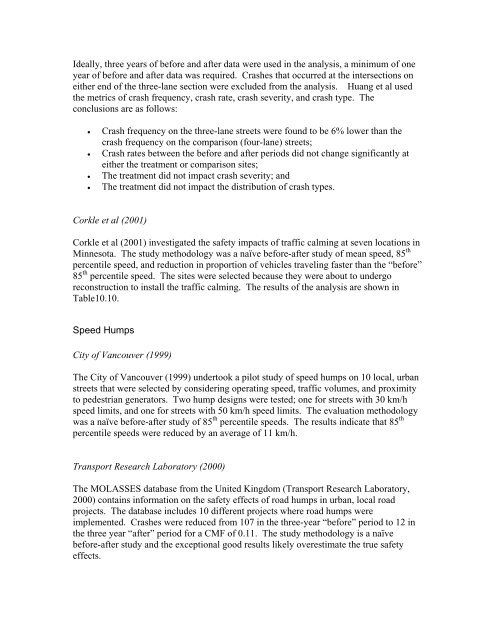Synthesis of Safety for Traffic Operations - Transports Canada
Synthesis of Safety for Traffic Operations - Transports Canada
Synthesis of Safety for Traffic Operations - Transports Canada
You also want an ePaper? Increase the reach of your titles
YUMPU automatically turns print PDFs into web optimized ePapers that Google loves.
Ideally, three years <strong>of</strong> be<strong>for</strong>e and after data were used in the analysis, a minimum <strong>of</strong> one<br />
year <strong>of</strong> be<strong>for</strong>e and after data was required. Crashes that occurred at the intersections on<br />
either end <strong>of</strong> the three-lane section were excluded from the analysis. Huang et al used<br />
the metrics <strong>of</strong> crash frequency, crash rate, crash severity, and crash type. The<br />
conclusions are as follows:<br />
• Crash frequency on the three-lane streets were found to be 6% lower than the<br />
crash frequency on the comparison (four-lane) streets;<br />
• Crash rates between the be<strong>for</strong>e and after periods did not change significantly at<br />
either the treatment or comparison sites;<br />
• The treatment did not impact crash severity; and<br />
• The treatment did not impact the distribution <strong>of</strong> crash types.<br />
Corkle et al (2001)<br />
Corkle et al (2001) investigated the safety impacts <strong>of</strong> traffic calming at seven locations in<br />
Minnesota. The study methodology was a naïve be<strong>for</strong>e-after study <strong>of</strong> mean speed, 85 th<br />
percentile speed, and reduction in proportion <strong>of</strong> vehicles traveling faster than the “be<strong>for</strong>e”<br />
85 th percentile speed. The sites were selected because they were about to undergo<br />
reconstruction to install the traffic calming. The results <strong>of</strong> the analysis are shown in<br />
Table10.10.<br />
Speed Humps<br />
City <strong>of</strong> Vancouver (1999)<br />
The City <strong>of</strong> Vancouver (1999) undertook a pilot study <strong>of</strong> speed humps on 10 local, urban<br />
streets that were selected by considering operating speed, traffic volumes, and proximity<br />
to pedestrian generators. Two hump designs were tested; one <strong>for</strong> streets with 30 km/h<br />
speed limits, and one <strong>for</strong> streets with 50 km/h speed limits. The evaluation methodology<br />
was a naïve be<strong>for</strong>e-after study <strong>of</strong> 85 th percentile speeds. The results indicate that 85 th<br />
percentile speeds were reduced by an average <strong>of</strong> 11 km/h.<br />
Transport Research Laboratory (2000)<br />
The MOLASSES database from the United Kingdom (Transport Research Laboratory,<br />
2000) contains in<strong>for</strong>mation on the safety effects <strong>of</strong> road humps in urban, local road<br />
projects. The database includes 10 different projects where road humps were<br />
implemented. Crashes were reduced from 107 in the three-year “be<strong>for</strong>e” period to 12 in<br />
the three year “after” period <strong>for</strong> a CMF <strong>of</strong> 0.11. The study methodology is a naïve<br />
be<strong>for</strong>e-after study and the exceptional good results likely overestimate the true safety<br />
effects.
















